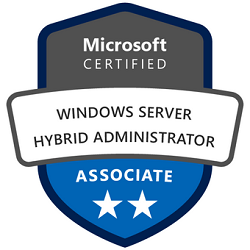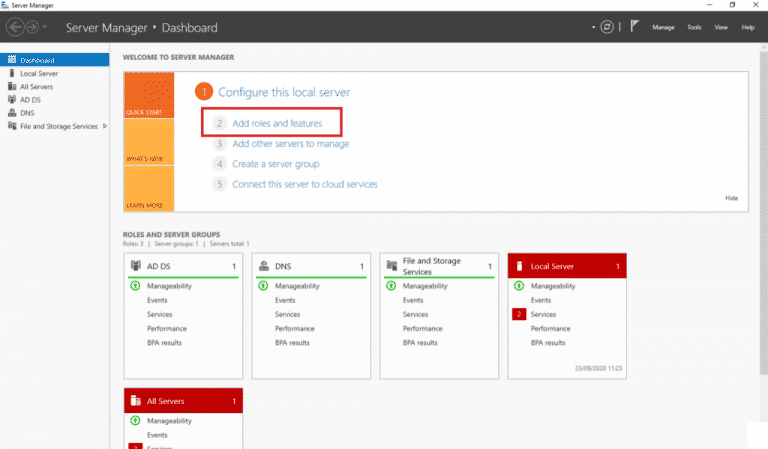Obiettivi | Certificazione | Contenuti | Tipologia | Prerequisiti | Durata e Frequenza | Docenti | Modalità di Iscrizione | Calendario

Il Corso Administering Windows Server Hybrid Core Infrastructure è progettato per preparare i professionisti IT all’installazione, gestione e manutenzione di Windows Server, con un focus specifico sull’infrastruttura on-premise e sulle soluzioni ibride integrate con Microsoft Azure. Il corso fornisce competenze fondamentali per amministrare ambienti server moderni, coprendo la gestione degli account utente, la configurazione delle policy di sicurezza, la gestione delle risorse di rete e la protezione dei dati aziendali attraverso backup e disaster recovery. I partecipanti impareranno a implementare e configurare Active Directory Domain Services (AD DS), DNS, DHCP e file server, oltre a esplorare le soluzioni di virtualizzazione con Hyper-V e l’integrazione con il cloud. Verranno inoltre trattati i principali strumenti di gestione e monitoraggio di Windows Server e Azure Arc, con particolare attenzione all’automazione delle attività di amministrazione tramite PowerShell. Il corso segue il curriculum ufficiale AZ-800 – Administering Windows Server Hybrid Core Infrastructure. Il Corso contribuisce alla preparazione dell’esame di Certificazione Windows Server Hybrid Administrator Associate (Esame AZ-800).
Sintesi Statistica :
- Corsi realizzati: 136;
- Numero Corsisti: 1564;
- Superamento Esame: 93,15%
Contattaci ora per ricevere tutti i dettagli e per richiedere, senza alcun impegno, di parlare direttamente con uno dei nostri Docenti (Clicca qui)
oppure chiamaci subito al nostro Numero Verde (800-177596)
Obiettivi del corso
Di seguito una sintesi degli obiettivi principali del Corso Administering Windows Server Hybrid Core Infrastructure:
- Installazione e gestione di Windows Server Hybrid Core Infrastructure, con integrazione on-premise e cloud.
- Amministrazione di Active Directory (AD DS) e Azure AD, gestione di DNS, DHCP e file server.
- Implementazione di backup, ripristino e disaster recovery per la protezione dei dati aziendali.
- Gestione della virtualizzazione con Hyper-V e integrazione con Azure.
- Monitoraggio e automazione della gestione dei server tramite strumenti nativi e PowerShell.
Certificazione del corso
Esame AZ-800 – Certificazione Windows Server Hybrid Administrator Associate; Questa certificazione valuta le competenze del candidato nell’amministrazione di ambienti Windows Server hybrid, con un focus sulle infrastrutture on-premise e sull’integrazione con Microsoft Azure. L’esaminato deve dimostrare la capacità di gestire e configurare Active Directory Domain Services (AD DS), inclusa la replica, il backup e il ripristino, nonché l’integrazione con Azure AD. Sono testate le competenze nella gestione di DNS, DHCP e file server, oltre alla configurazione e alla protezione dei servizi di rete. L’esame verifica la capacità di implementare e gestire la virtualizzazione con Hyper-V, compresa la configurazione di macchine virtuali, storage e networking, e l’uso di strumenti di gestione avanzata come Windows Admin Center e Azure Arc. Inoltre, il candidato deve dimostrare competenze nella gestione della security posture, inclusi access control, gruppi, policy di sicurezza e audit logging. Altre aree di valutazione includono la gestione dei backup e del disaster recovery, l’implementazione di soluzioni di high availability e il monitoraggio delle prestazioni attraverso strumenti nativi e PowerShell.
.
Contenuti del corso
AZ-800: Administering Windows Server Hybrid Core Infrastructure
Deploy and manage AD DS domain controllers
- Deploy and manage domain controllers on-premises
- Deploy and manage domain controllers in Azure
- Deploy read-only domain controllers (RODCs)
- Troubleshoot flexible single master operation (FSMO) roles
Configure and manage multi-site, multi-domain, and multi-forest environments
- Configure and manage forest and domain trusts
- Configure and manage AD DS sites
- Configure and manage AD DS replication
Create and manage AD DS security principals
- Create and manage AD DS users and groups
- Manage users and groups in multi-domain and multi-forest scenarios
- Implement Group Managed Service Accounts (gMSAs)
- Join Windows Servers to AD DS, Microsoft Entra Domain Services, and Microsoft Entra ID
Implement and manage hybrid identities
- Integrate Microsoft Entra ID, AD DS and Microsoft Entra Domain Services
- Implement Microsoft Entra Connect
- Manage Microsoft Entra Connect synchronization
- Implement Microsoft Entra Connect cloud sync
- Manage Microsoft Entra Domain Services
- Manage Microsoft Entra Connect Health
- Manage authentication in on-premises and hybrid environments
- Configure and manage AD DS passwords
Manage Windows Server by using domain-based Group Policies
- Implement Group Policy in AD DS
- Implement Group Policy Preferences in AD DS
- Implement Group Policy in Microsoft Entra Domain Services
Manage Windows Servers in a hybrid environment
- Deploy a Windows Admin Center Gateway server
- Configure a target machine for Windows Admin Center
- Configure PowerShell remoting
- Configure Credential Security Support Provider protocol (CredSSP) or Kerberos Delegation for 2nd Hop Remoting
- Configure Just Enough Administration (JEA) for PowerShell remoting
Manage Windows Servers and workloads by using Azure services
- Manage Windows Servers by using Azure Arc
- Create and assign Azure Policy that uses guest configuration extension
- Deploy Azure services using Azure VM extensions on non-Azure machines
- Manage updates for Windows machines
- Integrate Windows Servers with Log Analytics
- Integrate Windows Servers with Microsoft Defender for Cloud
- Manage IaaS VMs in Azure that run Windows Server
- Implement Azure Automation for hybrid workloads
- Create runbooks to automate tasks on target VMs
- Implement Azure Automation State Configuration to prevent configuration drift in IaaS machines
Manage Hyper-V and guest virtual machines
- Enable VM Enhanced session mode
- Manage VM using PowerShell remoting, PowerShell Direct and Secure Shell (SSH) Direct for Linux VMs
- Configure nested virtualization
- Configure VM Memory
- Configure integration services
- Configure Discrete Device Assignment
- Configure VM resource groups
- Configure VM CPU groups
- Configure hypervisor scheduling types
- Manage VM checkpoints
- Implementing high availability for virtual machines
- Manage virtual hard disk (VHD) and virtual hard disk v2 (VHDX) files
- Configure Hyper-V Network Adapter
- Configure network interface card (NIC) Teaming
- Configure Hyper-V Switch
Create and manage containers
- Create Windows Server container images
- Manage Windows Server container images
- Configure container networking
- Manage container instances
Manage Azure Virtual Machines that run Windows Server
- Manage data disks
- Resize Azure VM
- Configure continuous delivery for an Azure VM
- Configure connections to VMs
- Manage Azure VM network configuration
Implement on-premises and hybrid name resolution
- Integrate DNS with AD DS
- Create and manage DNS zones and records
- Configure DNS forwarding/conditional forwarding
- Integrate Windows Server DNS with Azure DNS private zones
- Implement Domain Name System Security Extensions (DNSSEC)
Manage IP addressing in on-premises and hybrid scenarios
- Implement and manage IP Address Management (IPAM)
- Implement and configure the Dynamic Host Configuration protocol (DHCP) server role (on-premises only)
- Resolve IP address issues in hybrid environments
- Create and manage DHCP scopes
- Create and manage IP reservations
- Implement DHCP high availability
Implement on-premises and hybrid network connectivity
- Implement and manage the Remote Access role
- Implement and manage Azure Network Adapter
- Implement and manage Azure extended network
- Implement and manage Network Policy Server role
- Implement Web Application Proxy
- Implement Azure Relay
- Implement site-to-site VPN
- Implement Azure Virtual WAN
- Implement Microsoft Entra application proxy
Configure and manage Azure File Sync
- Create Azure File Sync Service
- Create sync groups
- Create cloud endpoints
- Register servers
- Create server endpoints
- Configure cloud tiering
- Monitor File Sync
- Migrate Distributed File System (DFS) to Azure File Sync
Configure and manage Windows Server file shares
- Configure Windows Server file share access
- Configuring file screens
- Configure file server resource manager (FSRM) quotas
- Configure BranchCache
- Implement and configure Distributed File System (DFS)
Configure Windows Server storage
- Configure disks and volumes
- Configure and manage Storage Spaces
- Configure and manage Storage Replica
- Configure Data Deduplication
- Configure Server Message Block (SMB) direct
- Configure Storage QoS
- Configure file systems
Tipologia
Corso di Formazione con Docente
Docenti
I docenti sono Istruttori Autorizzati Microsoft e in altre tecnologie IT, con anni di esperienza pratica nel settore e nella Formazione.
Infrastruttura laboratoriale
Per tutte le tipologie di erogazione, il Corsista può accedere alle attrezzature e ai sistemi presenti nei Nostri laboratori o direttamente presso i data center del Vendor o dei suoi provider autorizzati in modalità remota h24. Ogni partecipante dispone di un accesso per implementare le varie configurazioni avendo così un riscontro pratico e immediato della teoria affrontata. Ecco di seguito alcuni scenari tratti dalle attività laboratoriali:

Dettagli del corso
Prerequisiti
Si consiglia la partecipazione al Corso Sistemista Informatico o competenze equivalenti.
Durata del corso
- Durata Estensiva 30 Ore;
- Durata Intensiva 4gg;
Frequenza
Varie tipologie di Frequenza Estensiva ed Intensiva.
Date del corso
- Corso Administering Windows Server Hybrid Core Infrastructure (Formula Intensiva) – 01/04/2025 – 09:00 – 17:00
- Corso Administering Windows Server Hybrid Core Infrastructure (Formula Estensiva Serale) – 22/04/2025 – Mar. Gio. 18:30/21:30
Modalità di iscrizione
Le iscrizioni sono a numero chiuso per garantire ai tutti i partecipanti un servizio eccellente.
L’iscrizione avviene richiedendo di essere contattati dal seguente Link, o contattando la sede al numero verde 800-177596 o inviando una richiesta all’email contatti@vegatraining.eu.


